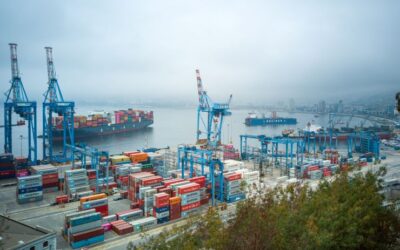
Agefi Luxembourg
– juillet 2022
Supply chain issues, Energy prices and swathes of relief fund
Xi Jinping’s zero-covid policies which placed millions under lockdown created bottlenecks in the supply of commodities and caused a surge in shipping costs. Exports are at record time lows, with industrial production falling to levels unseen before. Inventories have dropped to historic lows, especially for durable goods with high transport cost.
Import delays at Shanghai ports have increased sharply and the lack of drivers to transport goods is worsening the congestion. Exacerbating the situation is the hoarding of materials by manufacturers. This so called “bullwhip effect”, when compiled with the existing lack of resources and lean structures of supply chains has led to persistent mismatches between demand and supply and ultimately price increases.
The current supply chain structures prioritize efficiency over resilience, and have proved to be inflexible in meeting the unexpected surge in global demand. Dislocations are hard to repair and the current model pains to adapt to market needs. Meanwhile, the Fed has been busy printing money via its bond purchase programs. At the start of 2020, there was $ 4.0192 Trillion in circulation. This shot up to $ 20.0831 Trillion as at October 2021. In simple terms too much money is chasing too few goods and services, hence providing an incentive for producers to boost prices.
In addition to that, wages have grown at rates well above pre-pandemic levels of 2.5% across the G10, which is as fast as back in 2018. America and Canada who rely more on the services industries are suffering from the worst labour shortages, and Britain is facing a tighter labour market compared to France and Italy, where annual pay growth is below 1%. For a lot of firms, the bigger wage bill is simply passed on to consumers, adding to an already high inflationary environment.
Finally there is Russia’s offensive on Ukraine, the consequences of which has been skyrocketing energy prices and food shortages. Both countries are major producers of the global supply of oil, gas wheat, fertilizers and other materials, further pushing up energy and food prices, and causing the largest commodity shock since the 1970s.
The European Union draws approximately 40% of its gas imports from Russia, with Germany importing over half of its gas needs from the latter and being the most reliant due to its decision to simultaneously phase out nuclear and coal. The EU has been trying to diversify its suppliers towards Central Asian, Norwegian, North African and American producers while developing renewable energy, but is still a long way from achieving this. Renewables are subject to unpredictable weathers, nuclear is a contentious topic, several coal-fired power stations have closed and domestic gas production has plummeted. This has meant increasing reliance on Russian gas even in in times of sheer unpredictability.
In May European leaders decided to impose an oil embargo on Russia, with the exception of oil delivered via pipelines which makes up over 30% of purchases. A move which together with Shanghai’s tentative easing of restrictions, sent oil prices rising to their highest level in over two months. President Biden also issued a ban on oil and other energy sources but the US is far less reliant, with 8% of imported oil and products from Russia.
Even prior to the political moves, oil tankers have been subject to ‘self-sanctions’ with workers refusing to unload Russian cargos, players in the oil market worried about their reputations should they accept shipments, and a step back from financers providing insurance contracts. Again here, the mismatch between strong demand as the pandemic subsides and supply issues has resulted in inflationary pressures.
The invasion has also triggered a widespread food crisis. Globally Ukraine and Russia make up nearly 30% of barley supply, over 50% of sunflower oil exports, and 28% of wheat production. Moreover, Belarus together with Russia who are among the global top producers of a key fertilizer, potash used in agriculture are both facing export bans and sanctions. The attacks on the Black Sea and seizing of Ukraine’s coastlines has wreaked havoc in food supplies.
Denoted the “breadbasket of Europe” and feeding 400 million people worldwide, Ukraine is a top grain supplier to several developing countries that have seen skyrocketing food prices since the offensive started. The blockade has locked tens of millions of tons of grain in Ukrainian ports, which could also impact the subsequent harvest as silos remain full and there is no place to store or move next year’s yields.
These have led to other global players to ban their food exports in an attempt to stockpile homegrown crops, further inflating prices. Wheat is forecasted to rise by over 40% in 2022. According to the United Nations’ Food and Agriculture Organization, global food prices in April were up 30% compared to last year. Meat prices were 17% higher, cereals like wheat and maize were 34% higher and vegetable oil 46%.
Tight monetary policies, tighter economies
Up till November 2021, policymakers were still bickering about the trajectory that interest rates should follow. The US government was pumping out money into the economy to counter the effects of the pandemic and the focus was more on preventing an economic slowdown rather than on controlling inflation. Bank of England governor Andrew Bailey admitted being unable to stop inflation hitting 10% but indicated that interest rates would be raised in a bid to quell the issue. In May, the FED implemented its first half point rate rise since over two decades, with potential similar increases to be discussed at the next two meetings, and ECB’s Christine Lagarde is expected to halt the bank’s quantitative easing program and increase interest rates as early as July.
There is a dangerous balance to be met here between inflation hitting historic highs due to interest rates not being raised enough, or taking the risk of triggering a brutal recession by raising them too much. Back in the early 1980s when inflation hit 13.50%, the Federal Reserve raised fed funds rate to a record 20% triggering a massive recession in the process with unemployment rates reaching 11%. However, the state of the economy, the financial systems and debt levels are very different to what they were back then.
The Fed has been much warier of raising interest rates and is doing so at a prudent rate. The economy is more resilient and Basel 3 requirements has contributed to limit excessive leverage in the financial system. US annual households’ debt payments make up only 9% of disposable income, which is its lowest recorded levels since 1980. Cash buffers and savings are also larger thanks to stimulus payments and reduced spending due to the pandemic. A similar phenomenon has been observed in the Eurozone, with excess savings built up during the pandemic which would provide a cushion against a floundering economy.
The metric of most concern to individuals and politicians alike is the unemployment rate, currently standing at 3.6% in the US, 6.2% in the EU and 3.7% in the UK. The policies adopted to curb inflation might just cause the economy to go south as households curtail their spending, translating into lower business activities and reduced need for staff.
The silver lining is that the labour market has never been so tight, raising the possibility of a softer blow. Wage growth across the Eurozone has been picking up modestly, but is still below inflation levels. While this minimises wage push inflation, it also feeds into poorer consumption.
A moderation in demand would sway the manufacturing sector, already impacted by low confidence and excess inventories that retailers are finding to sell, to even lower activity levels.
However few economists expect an outright recession. Hiring expectations have remained solid, with over a quarter of businesses in Europe unable to increase production to meet demand due to lack of staff. The services industry in southern Europe has also been booming, with the tourism sector operating once again to near prepandemic levels.
Even if the economy is hit with a mild downturn, the energy shock will be a drag on and the impact will not be distributed evenly across countries. Many economists expect the euro area to be spared a recession, while the impact on poorer countries is still debatable. The food crisis may have severe repercussions across the globe on both short and long term, with again poorer nations being hit more harshly. The future will largely depend on how efficiently the matters at hand are dealt with.
Par Neeloufar Abdoolarid, Consultant Square.
AUTRES ACTUALITÉS EN SUPPLY CHAIN
Transformer la Supply Chain retail pour s’adapter à la demande client et aux enjeux de demain tout en restant compétitif
Paru dans E‑Commerce Mag.
L’IA et la peur de la boîte noire : l’exemple du DDMRP
Paru dans Supply Chain Magazine.
Digital Twin, une réponse aux chartes environnementales de la logistique et l’e‑commerce ?
Paru dans E‑Commerce mag




